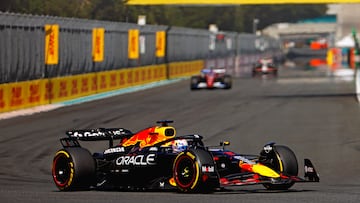This is how much money an F1 car costs: Specifications, weight, height and top speed
As we prepare for the 2025 Miami Grand Prix, it’s time to take a look at the star of the show, the car itself, from cost to weight and top speeds.

As is the case with everything in life, change and evolution are constant and that’s definitely been the case in the world of Formula 1 over the years. With weights and costs of cars now at an all-time high, so too are the speeds that they reach in what is motorsports’ premium class.
What does a Formula 1 car cost?
As the most technologically advanced automobile out there, you can imagine that a Formula 1 car is not cheap. Yet, how much does the final cost of a car come in at and what’s the actual breakdown of the cost, as it’s split across components like the engine, chassis and race consumables like tires and wheel bearings? To be clear, there is no official word on the exact cost of a Formula 1 car i.e. the figures we will present below are estimates based on insider information.
A Modern Formula 1 car costs over $20 Million to build, with almost 90% of the cost being the engine.#Ramadan #XMen97 @F1 #Eid2024 #EidMubarak pic.twitter.com/suNxTulVTJ
— Still Learning (@Still_learner) April 10, 2024
With that said, the rough approximation of the price of a Formula 1 car is a little over $20 million. This cost includes the aforementioned components and many others as well. For perspective, F1 has a new cost cap of $140 million, meaning the car constitutes 13% of the team’s expenses. Of course, we did say a ‘rough approximation’, which is to say there are no concrete figures when it comes to cost. In terms of what has been documented, you case see the breakdown below:
| Parts | Cost |
|---|---|
| Engine | $16.25 million |
| Chassis | $629,000 |
| Gearbox | $314,000 |
| Hydraulics | $155,000 |
| Rear Wing/DRS | $77,000 - $136,000 |
| Front Wing/Nose Cone | $126,000 |
| Floor/Bargeboards | $126,000 |
| Brake Disc/Pads | $69,000 |
| Extra Components | $45,000 |
| Steering Wheel | $44,000 |
| Fuel Tank | $28,000 |
| Halo | $15,000 |
| Tires | $2,600 |
| TOTAL | $17.9 million |
How much does a Formula 1 car weigh and how tall is it?
To be frank, weight counts for everything in the world of Formula 1, but surprisingly cars have been getting heavier over time. In 2023, cars are heavier than they’ve ever been in the history of the sport and this is largely due to the addition of safety features like the halo which weighs 7kg. It’s also worth noting that during a grand prix weekend the weight of the car can fluctuate immensely. This of course has led to the FIA setting a minimum weight for the cars which teams must attain.
The weight of a Formula 1 car through the years:
— Daniel Valente 🏎️ (@F1GuyDan) June 6, 2024
2010: 620 kg
2013: 642 kg
2014: 690 kg
2017: 728 kg
2021: 752 kg
2022: 798 kg
2026: 768 kg
Nimble cars are so much more visually appealing so 2026 is a good sign. pic.twitter.com/95ra4L16f9
So, how much does a Formula 1 car weigh? In total, 800 kg (1,764 lbs), which is 5kg up from the original limit of 795kg which teams apparently struggle to meet. Interestingly, there is in fact a plan to reduce the weight by 30kg for 2026. To be clear, the stated weight pertains to the car with a driver seated, fitted with dry-weather tires and no fuel.
As you can probably guess, each team’s car goes over this weight in varying amounts. To date, Alfa Romeo is said to be the only team that isn’t overweight, which is probably why they were directly opposed to the idea of increasing the minimum weight. Where the dimensions of the car are concerned, it’s interesting to note that while there is no maximum length the car can be no more than 200cm wide and 95cm tall.
Monaco isn’t the problem.
— Vincenzo Landino (@vincenzolandino) May 27, 2024
Compared to 1988, cars are ~250kg (550lbs) heavier and ~700mm (27 inches) longer.
That’s your problem. https://t.co/yyQ46Ks8ep pic.twitter.com/h4WOiI3neT
How fast is a Formula 1 car?
F1 cars accelerate from 0 – 60mph in roughly 2.6 seconds. Though that might not seem incredibly fast, the large majority of their speed comes from the aerodynamics - which come more into effect as the car moves faster – meaning they don’t go full-throttle from a standing start.
Related stories
Where the fastest F1 qualifying session is concerned, that was done by Kevin Magnussen in Mexico with a speed of 351.7km/h (218.5mph), while Valtteri Bottas currently holds the record for the fastest speed in an actual race with 372.5km/h (231.4mph) during the 2016 Mexican Grand Prix.
Did you know… F1 cars create over 4000kg of downforce at top speed 🤯
— Formula 1 (@F1) April 15, 2024
The latest episode in our F1 Explained series focusses on aerodynamics 🧐#F1 | Tap the clip to watch more ⤵️
If you’re wondering how that holds up against an IndyCar, it’s fascinating to note that while IndyCar is faster in a straight line, the F1 car is faster over an entire lap due to its exceptional downforce and cornering speeds. To put this in perspective, back in 2019 at the Circuit of America, both cars raced. The IndyCar pole time was 1m46.018s with an average speed of 186.349km/h, while the F1’s pole time set by Valtteri Bottas in 2019 was 1m32.029s, averaging 206.374km/h. Now you know.


Complete your personal details to comment